605190-M
Thrombin, Human Plasma
Synonym(s):
Thrombin, Human Plasma
About This Item
Recommended Products
biological source
human plasma
Quality Level
description
Merck USA index - 14, 9383
form
lyophilized
specific activity
≥1000 NIH units/mg protein
manufacturer/tradename
Calbiochem®
storage condition
OK to freeze
solubility
water: 1 mg/mL
aqueous buffer: soluble
storage temp.
−20°C
General description
Application
- as a component of endothelial growth medium (EGM) media for the transplantation and reisolation of Kaposi′s sarcoma-associated herpesvirus-human endothelial cell line (KSHV-HuARLT) cells from mice
- for the fabrication of fibrin gels
- as a component of EGM media for viral copy number analysis of KSHV-HuARLT cells and matrigel implant
Biochem/physiol Actions
Warning
Unit Definition
Physical form
Preparation Note
Reconstitution
Analysis Note
Legal Information
Disclaimer
Signal Word
Danger
Hazard Statements
Precautionary Statements
Hazard Classifications
Eye Irrit. 2 - Resp. Sens. 1 - Skin Irrit. 2 - STOT SE 3
Target Organs
Respiratory system
Storage Class Code
11 - Combustible Solids
WGK
WGK 1
Flash Point(F)
Not applicable
Flash Point(C)
Not applicable
Regulatory Information
Certificates of Analysis (COA)
Search for Certificates of Analysis (COA) by entering the products Lot/Batch Number. Lot and Batch Numbers can be found on a product’s label following the words ‘Lot’ or ‘Batch’.
Already Own This Product?
Find documentation for the products that you have recently purchased in the Document Library.
Our team of scientists has experience in all areas of research including Life Science, Material Science, Chemical Synthesis, Chromatography, Analytical and many others.
Contact Technical Service







